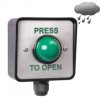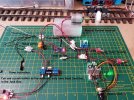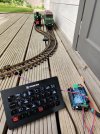I want to make a box with two timers activated by buttons, so that if my toddler and a friend are in the garden, I can let them 'run' the layout by just setting the speed controllers and hiding them away where only I can get to them, and leaving the kids with a chunky tactile button on an enclosed unit, that will make a train run for roughly long enough to clear that section/loop. They can then run around the garden following the trains, hammering the buttons to their hearts contents each time it stops. When I want to play with it, I just bypass or remove this box, and its back to controlling it myself with the speed controller.
So this was just an initial experiment using a timer switch that was on clearance at Toolstation. Not a final design. As per the video description its not ideal - I reckon its because this had a minimum input of 5w, and cranked up to full speed, a 0.5a starter handset only just about puts that out. Theres surely no 'off the shelf, readymade unit timer buttons' that would work for this purpose - fair enough I guess - I just need to find a timer module for low enough amperage/wattage, that I can link up to an IP65 rated control button. Preferably something big and tactile for toddler appeal, or that even lights up. Forgive the mess, its a rainy day and he'd been a sicky boy for the last 24hrs so more cuddling and calpol than tidying was done!
Feel free to point me at components on RSCompenents or CEF etc. Otherwise Im not averse to researching and working it out. Its just been a long time since A level D&T lessons and Im not an electrician!
The other thought I had is could I wire the switch before the controller (after the adaptor)? Its not an idea I like tbh, as having it between the controller and the track is what makes it removable. As I say it'd be the kind of thing I'd connect if we were having a BBQ or toddler play date in the garden.
So this was just an initial experiment using a timer switch that was on clearance at Toolstation. Not a final design. As per the video description its not ideal - I reckon its because this had a minimum input of 5w, and cranked up to full speed, a 0.5a starter handset only just about puts that out. Theres surely no 'off the shelf, readymade unit timer buttons' that would work for this purpose - fair enough I guess - I just need to find a timer module for low enough amperage/wattage, that I can link up to an IP65 rated control button. Preferably something big and tactile for toddler appeal, or that even lights up. Forgive the mess, its a rainy day and he'd been a sicky boy for the last 24hrs so more cuddling and calpol than tidying was done!
Feel free to point me at components on RSCompenents or CEF etc. Otherwise Im not averse to researching and working it out. Its just been a long time since A level D&T lessons and Im not an electrician!
Last edited:
-
1
- Show all







